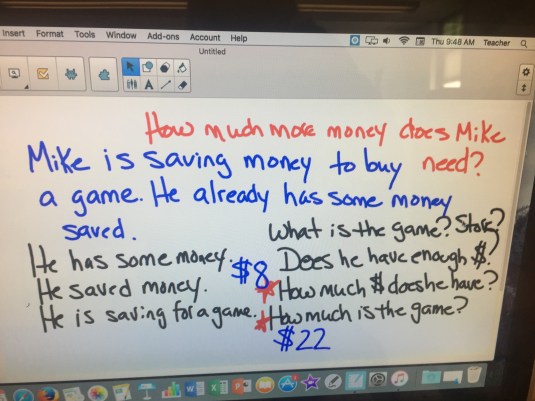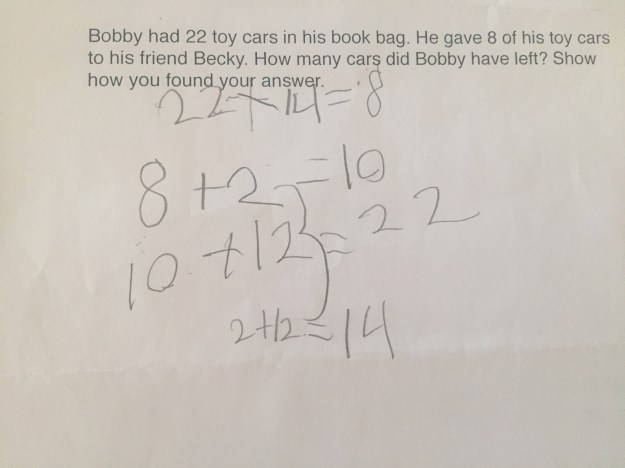From my own experience teaching 5th grade and a lot of conversations with teachers in grades 1-4, subtraction always seems to be such an area of concern with students. After the introduction of subtraction as take-away, students tend to live in that land forever. This idea was spinning in my head the entire time I read Zak’s article in NCTM’s Teaching Children Mathematics. The article came at an ideal time as I had just planned and taught a subtraction lesson in two second grade classrooms.
As we were planning, the teachers and I discussed two reasons we think students struggle with relational thinking when dealing with subtraction:
- The lack of variety in contexts we often give students to think about subtraction in different ways.
- The lack of explicitness in connecting the ways students solve various subtraction contexts.
Based on the problems they were doing in their Investigations unit, we wanted to take the same numbers and create two different contexts for subtraction…one as a take-away context and one as a distance context and then have the students think about what made them subtract in one and what made them add in another. (After reading Zak’s article I want to try another structure where we keep the same context, but change the numbers to see if that impacts their solution process.)
First we did a notice/wonder on the following scenario:
Mike is saving money to buy a game. He already has some money saved.
After collecting the things they noticed and wondered (in black ink), I asked them what question they think we could ask and solve based on this story. They gave the question in red ink and then I asked them what information they would need to solve it and I put a red star next that information. I told them the game cost $22 and he had $8 saved and sent the on their way.

Every single student added up, as we anticipated.
We shared some strategies and asked students how they were similar and different. We wanted to hear if students were using the number to solve or represent their thinking. We also wanted those students using the number to solve to see how they could also represent their thinking with equations.
Then we gave the students a second problem to solve: same numbers, different context:
Bobby had 22 toy cars in his book bag. He gave 8 of his toy cars to his friend Becky. How many cars did Bobby have left?
They all took away the 8 except for one student. The variety of strategies was great and we were actually surprised to see a student solve it the same exact way he had used in the previous context.
The lone addition solution…

We shared some strategies and asked them to compare the two problems. They noticed they were the same numbers and same answer but one student actually exclaimed, “How can they be the same answer when we added in one and subtracted in the other?!” What a great jumping off point for future lessons!
Time was up for this class period, but I made sure I stopped by to chat with the student who added in both because I was interested in his thinking. He said he knew that he had to subtract in that problem because it was taking away and he knew that you can add up to solve a subtraction problem. So, how does that happen? He has been in our school with all of these other students K-2, so how does he know this? What experience did he have, inside or outside of school, that allowed him to decide this was subtraction, know he can add up, and solve it? and then, Is there ever a context where he WOULD take away or has he learned this as to never have to take anything away?
After this lesson and Zak’s article, I am still reeling with my thoughts on subtraction. There has also been a lot of great conversation on Twitter about sequencing student work and I wonder how a set of student work like this could/would/should play in to students seeing subtraction more relationally? Lots of great stuff to think about!










Interesting approach with 2 contexts, I would like to try something similar with my grade 3s after the holidays.
So far, we’ve been playing with “The sum of 2 numbers is…The difference of these numbers is…”. We’ve done a some of modeling on a number line for it to look at the “distance” between 2 numbers. I found this was very challenging for many students; bringing things back from abstract numbers to more concrete scenarios might help.
Thank you for the post!
LikeLike
@howardat58 I did an experiment this year. In the beginning of the year, I gave kids a subtraction question like 63 – 18. 28 out of 50 kids did not get a correct answer. Most tried to do the algorithm and many subtracted 8-3. Second day, we had a problem “There are 75 kids in grade 3, 49 are boys, how many girls?” This time only 11 kids got it wrong. The range of strategies they applied to solve the second problem was beautiful.
It’s interesting that the textbooks for elementary that I’ve encountered usually put word problems at the end of the units on particular math operation, a pinnacle to be reached to apply your learned skills, instead of using them as a context for developing numeracy concepts and strategies.
LikeLike
Some kids indeed try “balancing” or “making convenient numbers”. Every year I see a challenge that many kids have with this strategy, they try to “balance” subtraction the same way as they balance addition – take from one number and add to another. I find that understanding subtraction as a difference is somewhat a pre-requisite for making sense of this strategy. I tried to work through it with cuisenare rods last year with some limited success. But it is definitely the strategy I struggle to teach in subtraction.
Regarding relating addition to subtraction, it should be the second nature but it isn’t. I ended up contemplating yesterday why I find teaching basic numeracy skills more challenging than working through some more complex topics in later grades. I think because operations has become an intuition long ago and I have no clue how I myself acquired this intuition. And how do you help your students to build an intuition?
LikeLike
My 9th graders struggle with this concept! We did a lot of remedial practice last semester, but nothing seemed to help. I like your approach, and I believe it will give my students another opportunity to “unlearn” the idea that all negative signs mean take away!
LikeLike
This is great stuff Kristin! Thanks for writing this up and sharing.
This question is everything – “How can they be the same answer when we added in one and subtracted in the other?!”
One thing that I find so interesting is that many, if not most, adults see the two problems you posed as subtraction. Or at least they would subtract to solve them. This seems to be prevalent with many teachers as well. They simply instruct students to subtract to find the answer to the Join, Change Unknown problem (or arguably its a part-part whole, part unknown) about Mike’s money.
But for so many second graders, they don’t see these two situation as subtraction. And as you noted, this is a critical starting place to begin that conversation. So cool!!
-Zak
LikeLike
That’s the beauty of purposeful pedagogy. Certain problem types lend themselves to certain strategies. Part-part-whole problems as well as compare problems do not give students action in the problem. Direct modelers can represent it different ways because it doesn’t give them an action to do. This allows for great “sharing out” as you compare strategies. Why can you add or subtract to solve it?
LikeLike